Rat Cage Setup Ideas & Tips to Encourage Activity [+ Photos]
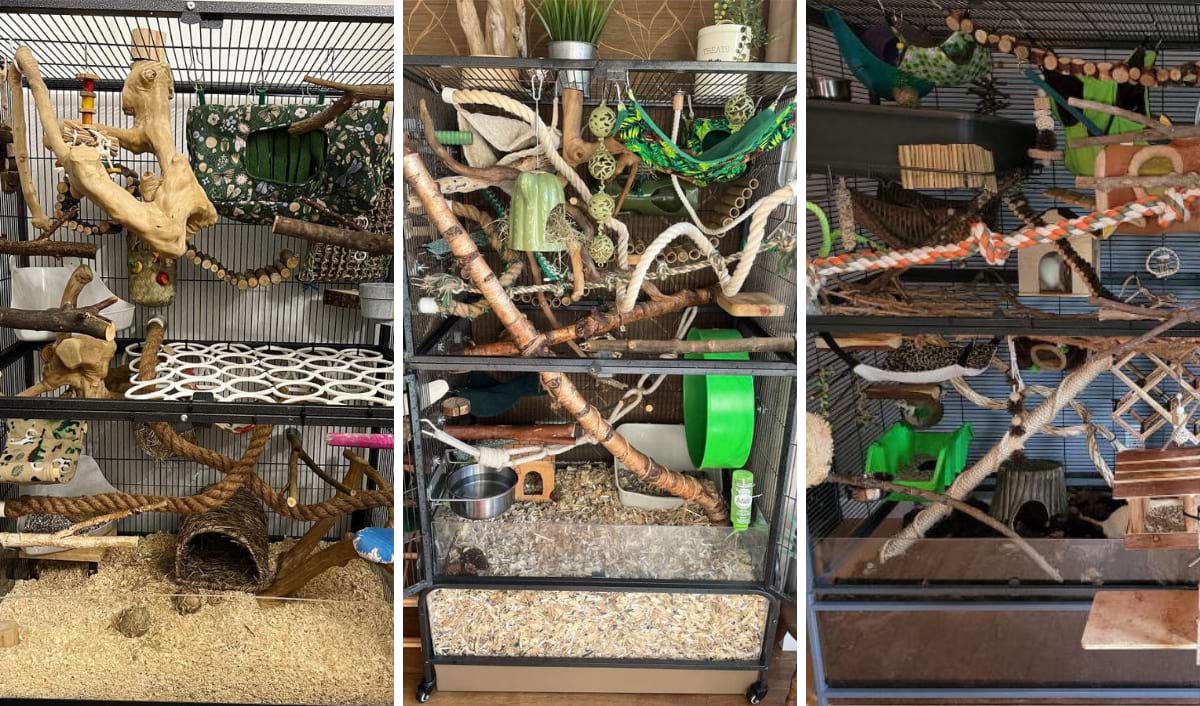
This weekend I’ve introduced two new neutered boys into my group (known as The Horde). That brings my total number of pet rats to eight – three neutered boys and five girls – and offers the perfect opportunity to change the rat cage setup and encourage everyone to get more exercise.
Setting up a large rat cage can be a challenge for new owners. Most cages come with a few basics like shelves, a hammock and maybe a house. However, these are rarely enough to keep rats entertained, and most owners will need a stash of spare cage furnishings to swap out for dirty items. So, what should we be looking for?
Taking a Rat’s-eye View
I like to start by looking at the cage layout from a rat’s point of view. It is easy for us humans to decide how we think a cage should look, but frequently, our rodent friends have their own ideas. Popping over to the cage right now, I find one girl asleep in her litter tray, while another has pushed the digging box away from the side of the cage and squashed herself down between the plastic and the bars. It isn’t quite what I intended!
Let’s think about what rats enjoy doing. Domestic fancy rats are Rattus norvegicus, a species that digs extensive burrows in the wild, but also climbs buildings and trees, and can travel several hundred meters to find food. So, a cage to keep rats happy and healthy is a cage set-up for digging, climbing and running.
Digging
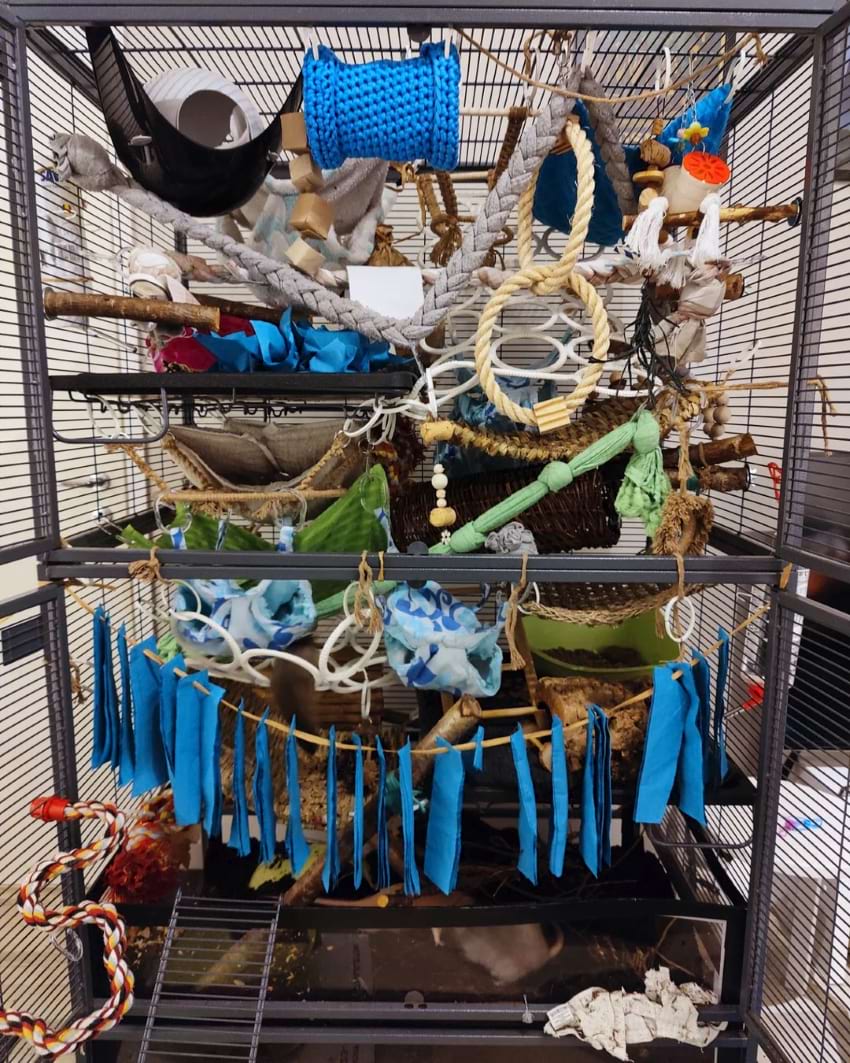
My rats love a good dig in a thick substrate. Often, I bury nuts or other treat items for them to find, but they also dig just because they want to, because they fancy making a hole or burrow.
In cages with deep plastic bases this is easy to set-up – just fill the base with suitable bedding such as:
- cardboard squares,
- cross-cut shredded paper,
- hemp
- paper bedding (natural and unscented)
- shredded coconut fiber small animal bedding,
- sterile coco soil (often used in bioactive setups)
- or safe large wood shavings (kiln dried and low dust).
The substrate should be non-toxic, dust-extracted, and free from long fibers that rats could get their necks or legs tangled in.
However, like many enthusiastic rat owners, I’ve fallen in love with the Critter Nation style of cage, which has a fully opening front. They are so easy to clean! Unfortunately, they also have flat base trays that don’t work with substrate unless you want it spread halfway around your house.
Some people solve this problem by making custom bases out of the corrugated plastic (corflute) you can buy in DIY stores. Since my horde is into chewing holes in their trays, I prefer to give them a range of digging boxes that are either harder to chew or disposable. Things I use include the deep bases from smaller cages, which you can often pick up cheaply second-hand, and plastic troughs that are sold for growing plants on window sills.
My favorite option though is a big cardboard box. These are often free if you ask nicely in a local shop, and they can be customized with extra doorways for burrows under the substrate. And because they are free, it doesn’t matter if the rats decide to indulge in some redecoration of their own.
Climbing
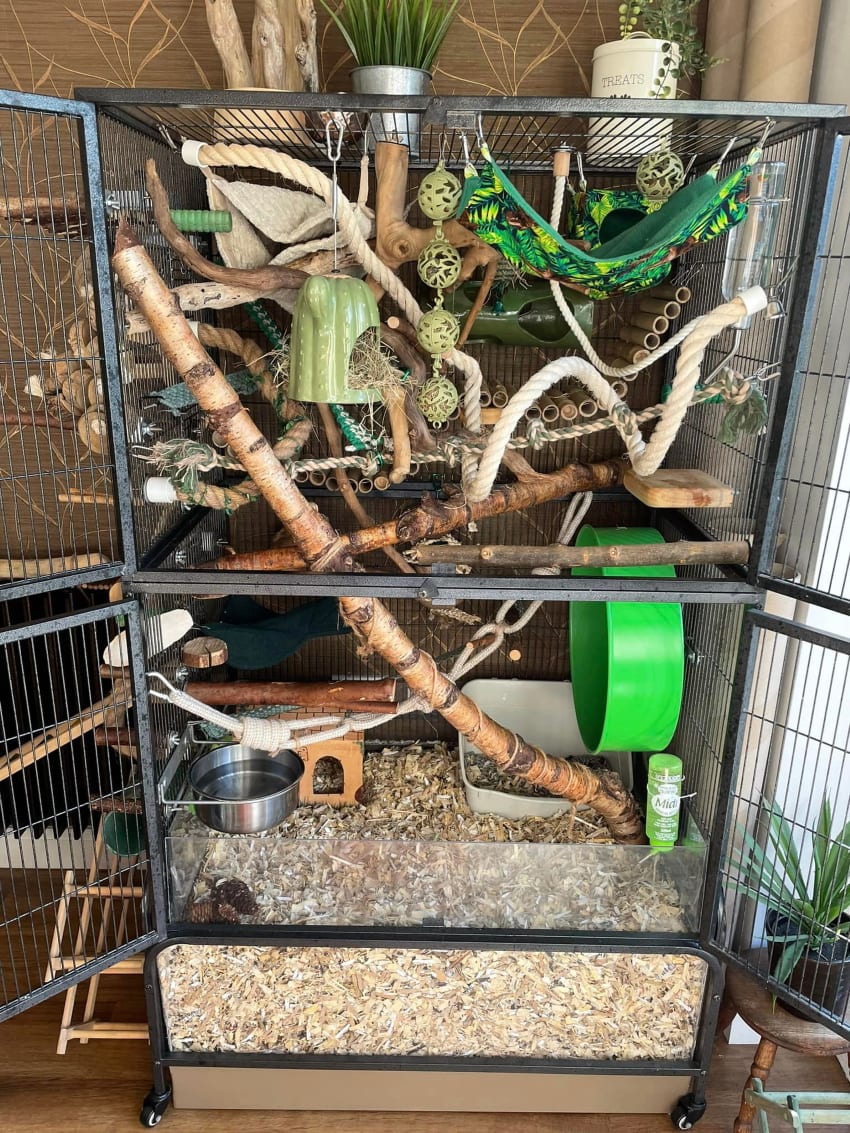
Most cages come with ladders to help rats move between levels. However, unless you have an oldie in your group, they really aren’t necessary. One thing that rats are excellent at is climbing – as my girls like to demonstrate by going vertically up curtains or internal brick walls. All they need to get about a cage are the cage bars, and enough odds and ends to clamber between.
Ropes
We love including ropes so they can move up and around the cage in unexpected ways. I usually buy from the parrot section of pet-shops, but you can also make your own out of any clean natural fibre rope, as long as you are careful not to leave any holes, snags, or dangling fibres where feet, heads or toes can get caught.
Fruit Tree Branches
Another popular option for climbing is to include fruit tree branches – apple, pear, plum and cherry are all safe woods (see a list of safe woods here). Use wet heat as described in our safe woods post to get rid of any bugs or parasites that might be hiding in the bark.
Branches should be wedged or wired securely into the cage, and any sharp pointy bits that might injure a falling animal should be removed.
Climbing Perches
If you don’t have fruit trees available, a cheap way to make climbing perches is to get some 2 cm (or 1 inch) diameter dowel from your local DIY shop, cut it to the length you want, and drill a bolt into one end. You can then fix these to the bars using a washer and nut on the outside – and the rats have a branch to perch on or leap from.
I have loads of these, as my fruit trees are far too baby to be pruned, and I find that although they get chewed, they last and work brilliantly.
I clean all the cage toys, including ropes and wooden bits, by washing in hot water with a veterinary disinfectant.
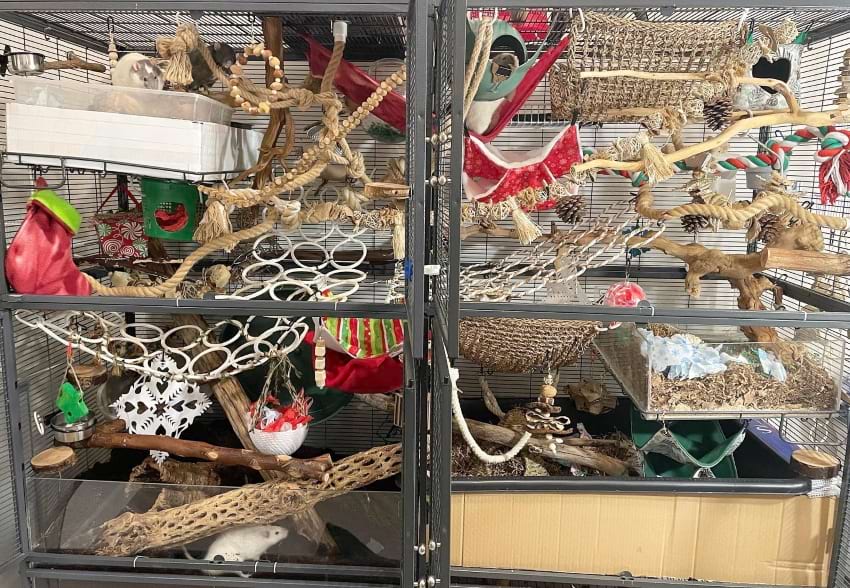
Running
Just like humans, rats need physical exercise to stay fit and healthy, and as well as climbing, a great way for them to do this is to run about. As cages have limited space, many owners like to put a wheel in. The key thing here is to choose one that is big enough for an adult rat to run on safely, which means one of the big silent spinners, silent runners / wooden wheels, or flying saucers.
The wheel needs to be at least 30 cm (12 in) across, otherwise it can damage the rat’s spine. It is also important that wheels are made of solid plastic or metal, not metal bars, as rat tails can get caught in rotating bars and damaged.
Not all rats will use wheels, especially if they aren’t raised with them as babies. I like to put one in if I have room, but I also encourage my rats to spend as much active play time out of the cage as possible – and strategies for that are another blog post.
Cage Accessories

When setting up a rat’s cage, it’s important to make sure there’s enough space for them to stretch and play without it being too crowded. At the same time, we don’t want any empty or wasted space either.
Safety is crucial when it comes to decorating the cage, so we need to avoid anything that could harm the rats, like sharp edges, toxic materials, or high drops. But beyond these safety considerations, we have plenty of room to get creative and make the cage a fun and engaging environment for our rats.
A few cage accessories that your rats will welcome:
- hammocks
- houses and boxes
- tubes
- tunnels
- igloos
- sputniks
- lava ledges
- wooden wine racks
To protect our rats from falls, we need to ensure there’s no straight drop from the top of the cage to the bottom. One way to do this is by including fall breakers in the middle of the cage, preventing them from falling all the way down if they slip.
Items you can use as fall breakers include:
- scarf hangers
- rope nets (you can weave these yourself too)
- large flat hammocks
- ladders turned horizontally
- seagrass nets for birds
Aside from enrichment, rats require designated areas for toileting, as well as food and drink accessories. These include:
- litter trays filled with litter material (and an optional pee rock)
- water bottles (at least two in case one malfunctions)
- food bowls (optional if you scatter feed only)
Even in a large and fancy cage, most of the space can be considered wasted from the rats’ perspective if we don’t decorate it well. It’s important to create an engaging and stimulating environment that encourages rats to dig, climb, run, explore, and use all the available space. Otherwise, they may become bored and stressed.
Awesome Rat Cage Setups [PHOTOS]
Get inspired by these awesome rat cage setups from other rat owners.
Want even more inspiration for your rat cage setup? You can join this group on Facebook for more ideas!

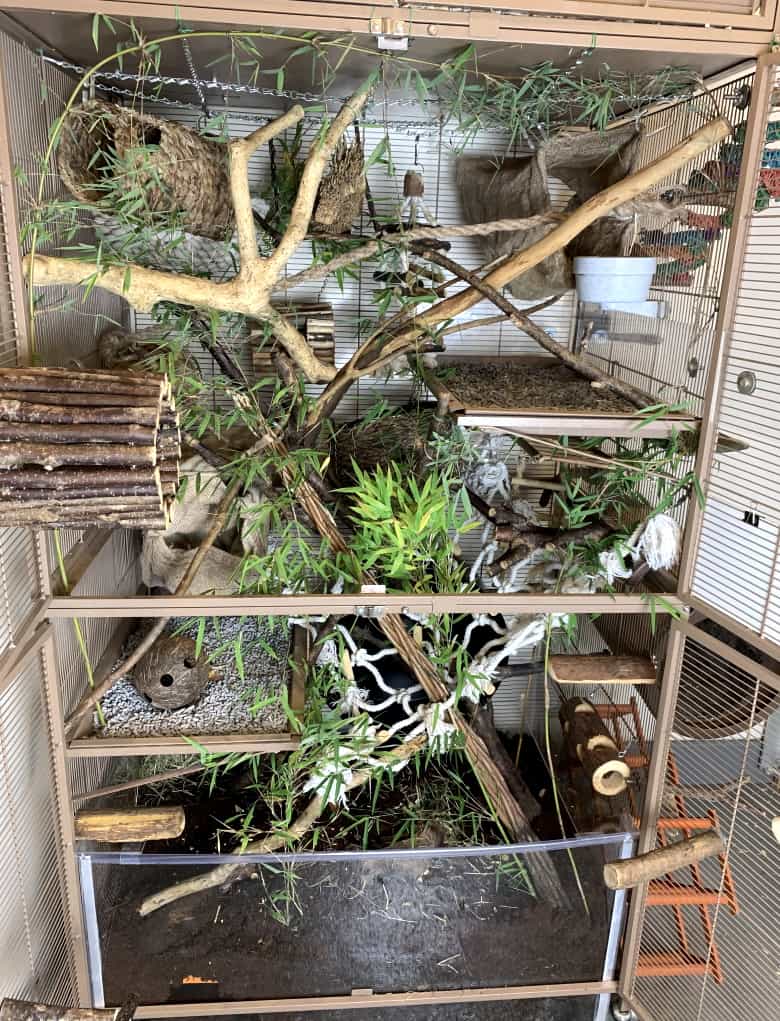

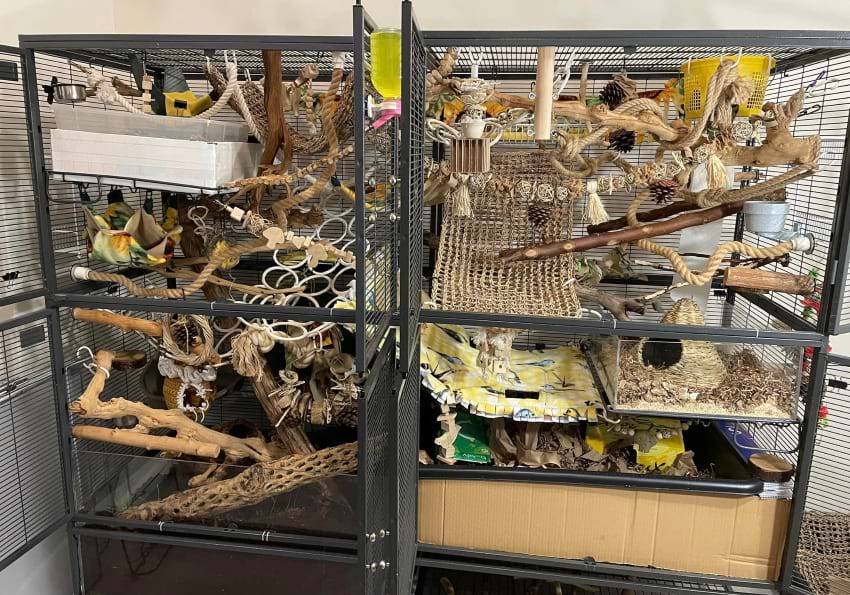
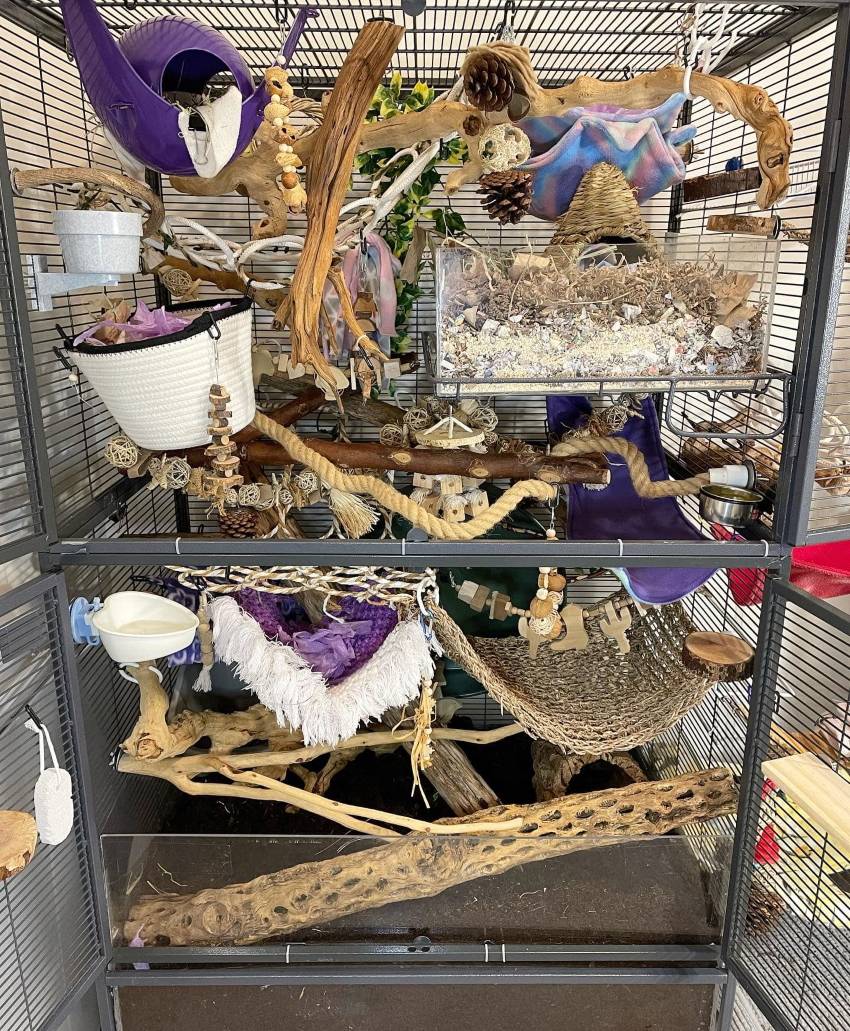
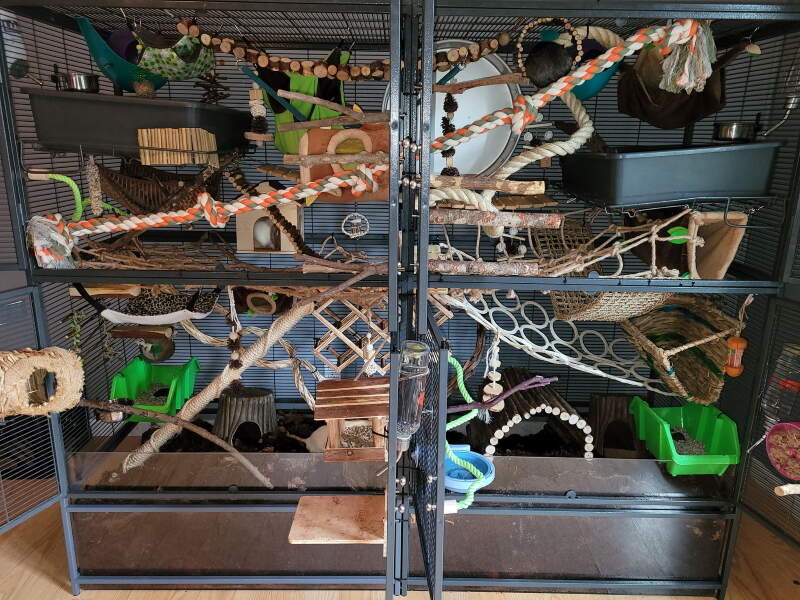
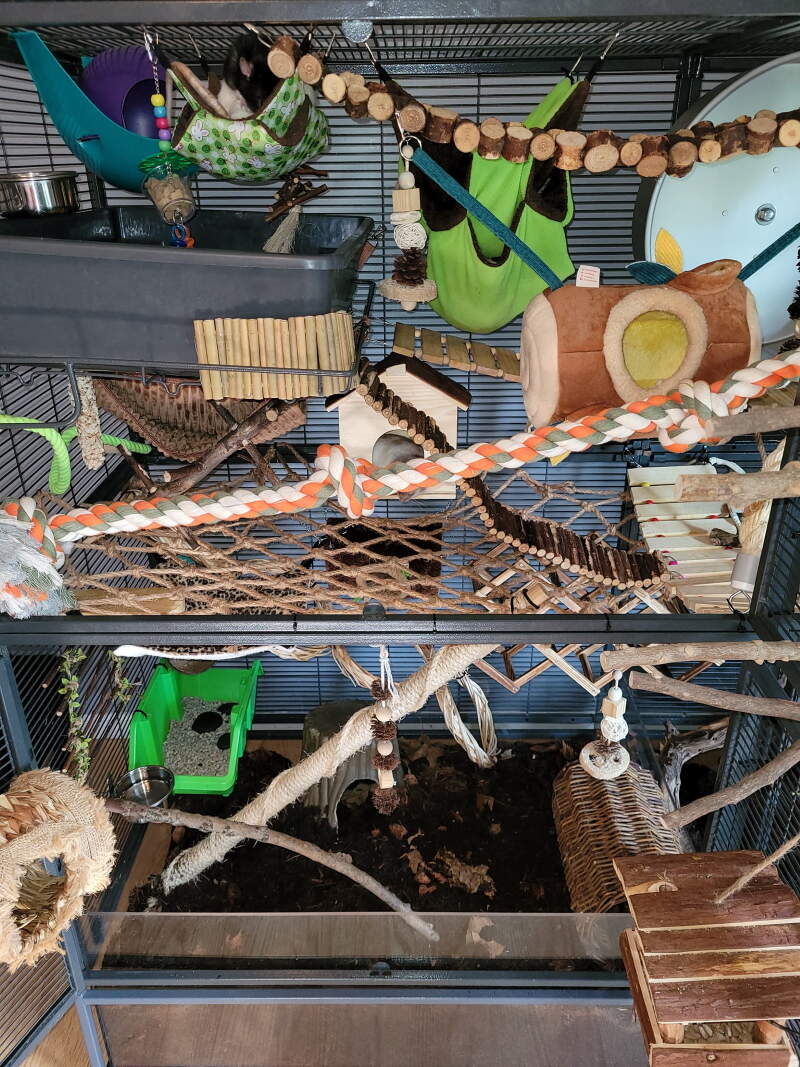

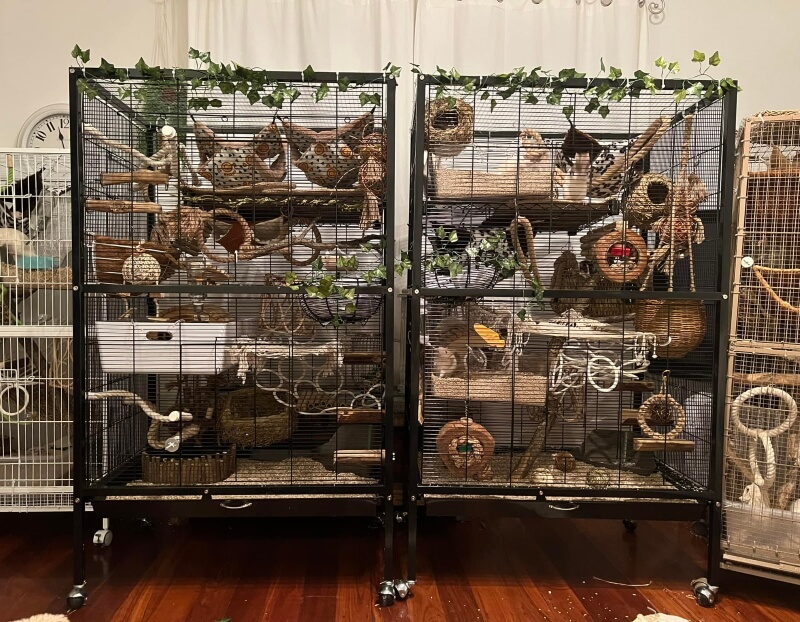


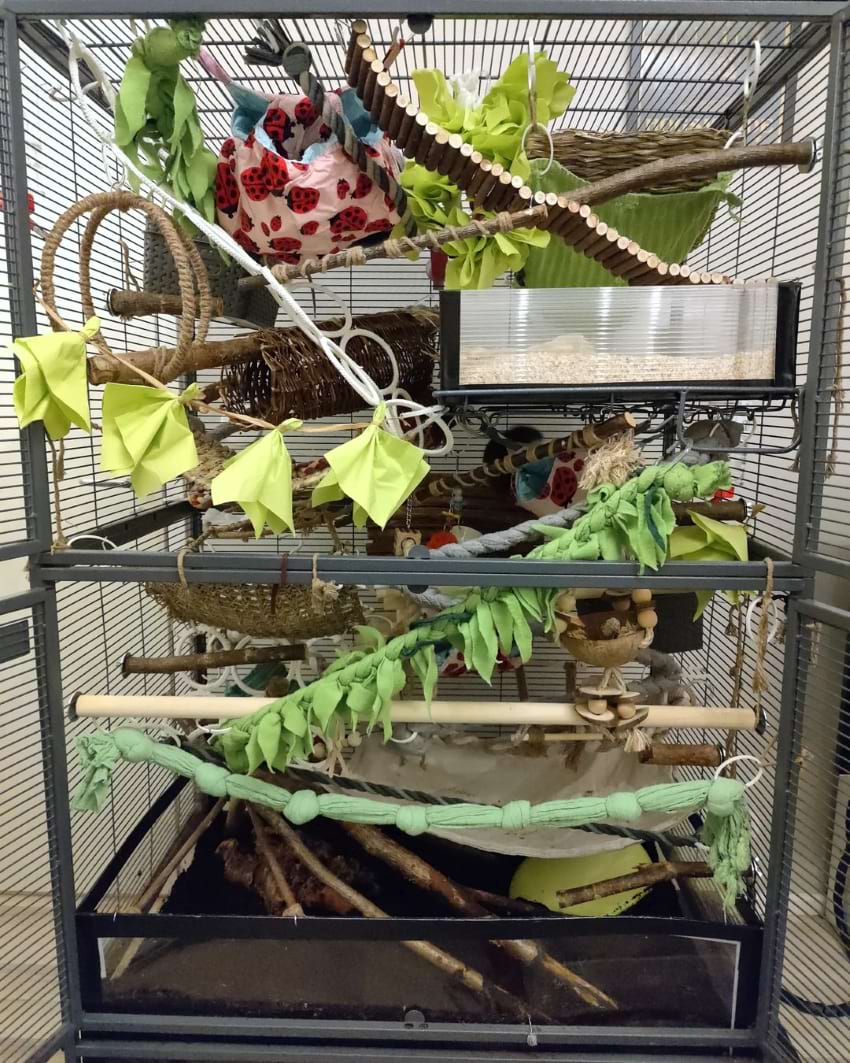



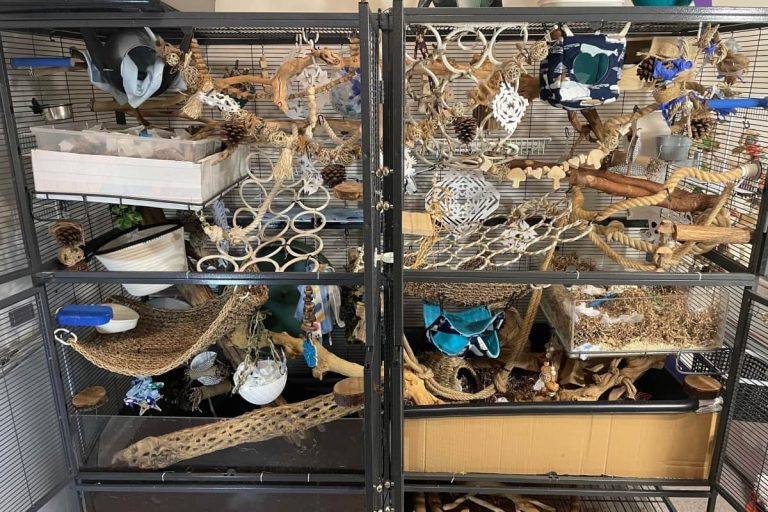


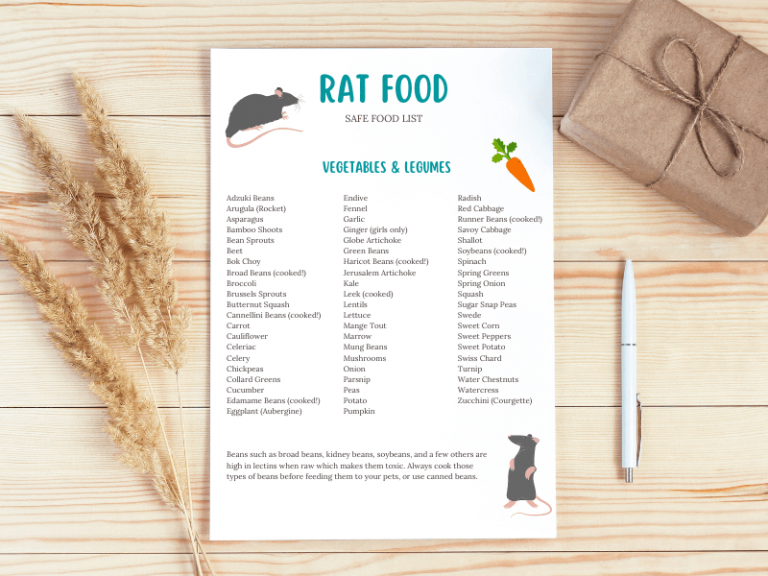

I’m a complete novice when it comes to rats. I grew up with guinea pigs, I have 5 today. They are highly sensitive, especially with respiratory issues, and like rats same they too need a roomy house and accessories. So far I’m ok yet I still find my self a nervous new rat “mom”. Your site is incredibly helpful! Thank god I have an amazing vet (gpigs need exotic vet too, and ours is truly wonderful), I would be double so nervous if I hadn’t a good vet. I’m going to implement your advice, cleaning, and set up. The sisters are only about 3 months young. I hope I’ll be the best carer to them. I feel I have a lot to learn, and I have a million questions do I’m glad I found you ! Thank you !!!
Yay, I’m glad you like our website and find it helpful! It motivates us to keep going 🙂
Yes, having a great vet who is knowledgeable and experienced with small pets is very important.
I am very glad I came across this website. Ive had my 2 male rats for a couple moths now and I feel as if there cage isn’t very full. My boys are always excited to try new toys and adventure around. They get bored of their toys in their cage quick, so it is helpful to have something new in the cage! Thank you! Also please post more I am always eager to learn some more things about rats!
Thank you for visiting our blog 🙂 We’re glad we can help!
Hiya this website is very cool I have 3 male rats of my own and thinking of re designing there cage setup just wondering where I’d be able to buy all these thing for good quality that won’t break yet are cheap. Thx
Is it ok to use wooded items from Michael’s and/or craft paint to build awesome houses or decorations for the cage? I have a theme in mind but it requires some crafting.
I’m not familiar with Michael’s, but if the wooden items are made of heat treated pine they should be fine. I would avoid composite woods like chipboard.
For craft paint look for child / pet safe non-toxic brands.
I’m so glad I found this post! I have had rats before, but was never sure how to decorate their cage or what they would like. Thanks to this post, my brand new babies will grow up in an active environment!
Thank you for visiting! I’m glad you find it helpful 🙂
I have run a rat rescue for the past 13 years. Literally thousands of rats have come through our doors. I thought all of your cage info sounded pretty good and we were going to use your website as a resource for new adopters. That was until we saw the pictures you’re recommending of other people’s cages. Unless these people have wild rattus rattus (roof rats) that excel at climbing and reaching high places, these clustermucks of a cage are so scary and dangerous! I’m actually flabbergasted. I find it hard to believe the rats that have had to try live in these cages have remained healthy and haven’t had any dangerous falls as they got older. Wild Norway rats rarely climb. They are typically ground dwellers. I’m also pretty sure your pet rats are a thousand times removed from their wild ancestors. So yes, while digging boxes for out of cage time are a great idea, these high climbing cages with no shelves, dangerous ropes, branches and the plastic rings etc. are just a recipe for disaster. I’m sad that these rats have to live in a such a dangerous obstacle course.
Thank you for your comment.
I understand that wild Norway rats live in burrows and mostly spend time on the ground, but they are still avid climbers and have no issues climbing ropes or other obstacles. They are less skilled than roof rats but are still good at climbing. After all, their tails are here to help them keep balance.
It would be great if all rat owners could provide pet rats with a few-meters-long cage that would better resemble their natural habitat so they can run around and live in burrows, but that is not possible for most rat owners. The rat cages on the market are rarely long enough to provide pet rats with huge running areas. So to provide more space, we need to go up in height. From what I’ve seen, rats enjoy climbing ropes, branches, cage bars, and much more… Climbing brings their heart rates up and keeps them in shape.
I’d love to see the type of cage setup that you recommend. You can leave a link here so we can take a look.
I’m open for discussion – there’s always more to learn! After all, human knowledge of rat care is still limited, and we don’t have the data on what kind of cage setups rats actually prefer. We can only guess based on the behavior of their wild counterparts.
I’m new to this and from what I understand rats like to burrow,I noticed in some of the pictures there was substrate in the bottom,my question is How to make the substrate deep enough yet contained within the cage?
Hi, the best way is to get acrylic sheets cut to size for your cage at Professional Plastics or a similar supplier. There are step by step instructions on how to make a bin in this video (starts at 7min): https://www.youtube.com/watch?v=nQC7RWzaYqA&ab_channel=TheBohoRat . A cheaper option would be to add a cardboard box to the bottom of the cage but that will have to be swapped often. You might also be able to find a plastic storage bin that fits your cage blueprint.
Here in the USA, alot of people buy the large concrete mixing tubs from Home Depot or Lowes, for their the Critter Nation, it fits at the bottom of the cage so you can have a digging area. I just got my 1st Critter Nation cage h I haven’t been able to get to Lowes, but from what I understand you take out the bottom rack & it fits perfectly in that spot, no holes for escaping. I had a small one in my old cage & my boys could barely chew through the plastic concrete mixing tub, they’re pretty thick.
I’ve made houses, 2 stories high out if popsicle sticks & non-toxic glue, painted w/non-toxic acrylic paint, to slow the absorption of pee. I just noticed Mod Podge is also non-toxic, which would help seal, wood popsicle sticks, & even cardboard.
I’ve made tunnels out of oatmeal canisters (cardboard), placed 2 end to end after cutting the bottom off, used brown paper(paper grocery bag) type paper, rolled the paper around the tube’s & non-toxic glue, viola a tunnel.
I had a couple of boys that didn’t like to be handled, so I took a fold out long table, 6-8 foot long, placed it by the cage, put said tunnel from cage to table & they were easily & safe to them to get on table & back to cage(they were pet store rats, took longer to bond), I’d put boxes, tunnels, cat toys & hides on the table, on top of a blanket. The table was high enough where they wouldn’t jump, but boy did they figure out how to climb on the outside of the cage, hee hee, smart babies.
I also have double of hammocks, hides, ropes, & multiple lava ledges(great for sharp nails) you could also put water & food bowl up a little higher & put a rough red brick below them so they have to climb on the brick.
You can make foraging toys out of TP rolls & TP, put food & healthy treats, nuts etc, fill both ends with tissue & put in cage, they love it & it also gives them nesting material.
Sorry si long, but I wanted to give some DYI stuff, especially for people who are on a fixed income, or to save money for vet bills, food etc.
I give my babies baby food for treats & supplements, less salt & sugar.
Thank you. Lots of great ideas!